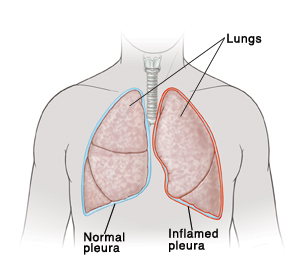Pleurisy
Pleurisy
You have pain in your chest. Your healthcare provider has told you that you have pleurisy, or pleuritis. Pleurisy is swelling (inflammation) of the pleura. The pleura are two layers of thin smooth tissue that surround the lungs and line the chest.
What are the symptoms of pleurisy?
Pleurisy usually causes sharp chest pain. It is usually worse when you take a deep breath, cough, or sneeze.
What causes pleurisy?
Many things can cause pleurisy. A common cause is a viral infection like the flu or pneumonia. Serious lung problems that can cause it include:
A blood clot in the lung (pulmonary embolism)
Air between the pleura (pneumothorax)
Serious heart problems that can cause pleurisy include:
Heart attack
Inflammation of the covering of the heart (pericarditis)
How is pleurisy diagnosed?
Your healthcare provider examines you and asks you about your symptoms and health history. He or she will first check you for the serious causes of chest pain. You may have:
Lab tests
Imaging tests such as chest X-ray, CT scan, or ultrasound
ECG
How is pleurisy treated?
Treatment depends on what is causing the pleurisy. Serious conditions are treated in the hospital. You may need medicines to decrease the inflammation and pain.
Call 911
Call 911 if any of these occur:
Trouble breathing
Chest pain that gets worse
Call your healthcare provider
Call your healthcare provider right away if you have:
A fever of 100.4°F (38°C) or higher, or as directed by your healthcare provider
Updated:
September 02, 2017
Sources:
Pathophysiology and Treatment of Fever in Adults. UpToDate.
Reviewed By:
Adler, Liora C., MD,Fraser, Marianne, MSN, RN
